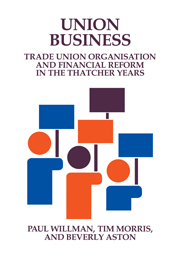Book contents
- Frontmatter
- Contents
- Acknowledgements
- 1 Introduction: unions in the 1980s
- 2 The financial status of British trade unions 1950–1989
- 3 Financial differences between unions
- 4 The role of financial matters in union organisation
- 5 The politics of union finaces
- 6 Union size, growth, and financial performance
- 7 Strike activity and union finances
- 8 The National Union of Mineworkers: strikes and financial disaster
- 9 The GMB: merger and financial reform
- 10 The Amalgamated Engineering Union: back from the brink
- 11 The Banking, Insurance and Finance Union: competitive unionism and financial survival
- 12 The Electrical, Electronic, Telecommunications and Plumbing Trade Union: accountability and financial control
- 13 Conclusions: union business and business unionism
- Appendix 1 Research methods
- Appendix 2 Regression results
- Appendix 3 Questions for finance officers
- Appendix 4 Questions for General Secretaries
- Appendix 5 Questionnaire: trade union finances
- Appendix 6 The number of trade unions
- Notes
- References
- Subject index
- Index of trade unions
- Author index
1 - Introduction: unions in the 1980s
Published online by Cambridge University Press: 11 March 2010
- Frontmatter
- Contents
- Acknowledgements
- 1 Introduction: unions in the 1980s
- 2 The financial status of British trade unions 1950–1989
- 3 Financial differences between unions
- 4 The role of financial matters in union organisation
- 5 The politics of union finaces
- 6 Union size, growth, and financial performance
- 7 Strike activity and union finances
- 8 The National Union of Mineworkers: strikes and financial disaster
- 9 The GMB: merger and financial reform
- 10 The Amalgamated Engineering Union: back from the brink
- 11 The Banking, Insurance and Finance Union: competitive unionism and financial survival
- 12 The Electrical, Electronic, Telecommunications and Plumbing Trade Union: accountability and financial control
- 13 Conclusions: union business and business unionism
- Appendix 1 Research methods
- Appendix 2 Regression results
- Appendix 3 Questions for finance officers
- Appendix 4 Questions for General Secretaries
- Appendix 5 Questionnaire: trade union finances
- Appendix 6 The number of trade unions
- Notes
- References
- Subject index
- Index of trade unions
- Author index
Summary
It would be hard to argue that the 1980s was a successful decade for British trade unions. Whether one turns one's attention to membership levels, to union density, or to the outcome of several of the larger disputes of the decade, the picture is one of retreat or defeat. Union influence over various aspects of government policy directly or indirectly affecting industrial relations was minimal. Successive pieces of legislation dealing with the rights of trade unions and of their members were criticised and rejected by unions themselves yet enacted, apparently with a level of popular support which must have included that of many union members. In 1983 and 1987, many of those members reaffirmed their rejection of the policies of the Labour Party, the preferred political party of many union leaders, voting instead for the confirmation of policies which, not just pragmatically or occasionally but ideologically and systematically, rejected values and beliefs close to the core of British trade unionism. The latter half of the decade saw a distancing between the previously closely linked institutions of the labour movement. Not only was the Labour Party in opposition seeking to reduce a perceived source of electoral disadvantage by stressing the independence of its policy making from the views of trade union leaders but also, within the TUC, there were splits over both organisational and political matters, resulting in the expulsion of EETPU in 1988, the most serious split within the movement since 1945.
If all was not gloom, the bright spots were scarce, and did not illuminate any clear path to recovery.
- Type
- Chapter
- Information
- Union BusinessTrade Union Organisation and Financial Reform in the Thatcher Years, pp. 1 - 6Publisher: Cambridge University PressPrint publication year: 1993



